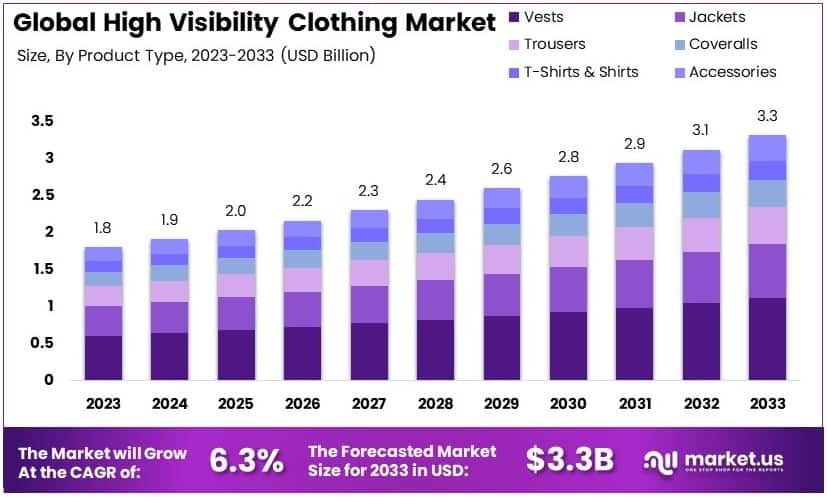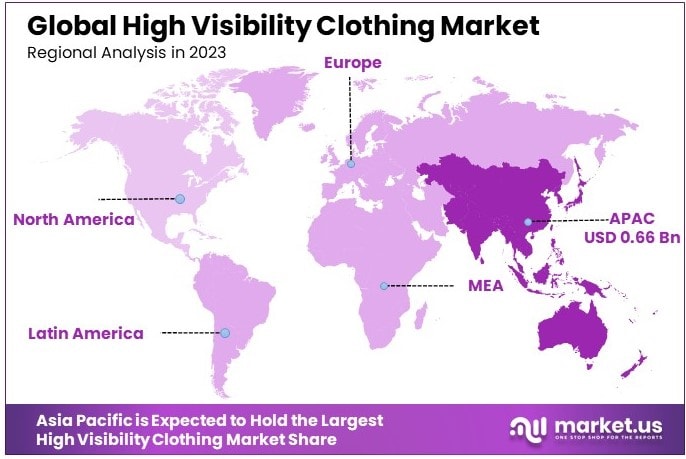Table of Contents
Introduction
The Global High Visibility Clothing Market is projected to reach approximately USD 3.3 billion by 2033, increasing from an estimated USD 1.8 billion in 2023. This growth is anticipated to occur at a compound annual growth rate (CAGR) of 6.3% during the forecast period spanning from 2024 to 2033.
High visibility clothing, often referred to as hi-vis apparel, comprises garments made from fluorescent materials with reflective strips, designed to ensure maximum visibility of the wearer in various lighting conditions. These garments are crucial for individuals working in environments where safety is a priority, including construction sites, roadside operations, emergency services, and industrial facilities.
The high visibility clothing market refers to the global industry involved in the production, distribution, and commercialization of these safety garments across multiple sectors. Growth in this market is primarily being driven by stringent workplace safety regulations and increasing awareness regarding occupational safety standards, particularly in developed economies such as the United States, Canada, Germany, and the United Kingdom.
Additionally, the growth of construction and infrastructure projects worldwide has significantly elevated the demand for high-visibility workwear. The rising implementation of safety protocols by governments and corporate entities, coupled with increased investments in public infrastructure and transportation, has further supported market expansion. Demand is also being driven by the transportation and logistics sector, where visibility is critical to prevent accidents and ensure worker protection.
Moreover, the integration of advanced fabric technologies such as breathable, weather-resistant, and flame-retardant materials into high-visibility clothing has expanded its applicability and appeal. The market presents a substantial opportunity for innovation in smart high-visibility apparel, which integrates features such as wearable sensors and connectivity for health monitoring and enhanced worker tracking.
The increasing adoption of these technologies, particularly in high-risk industries, is expected to offer long-term growth prospects for manufacturers and suppliers within the high visibility clothing market.

Key Takeaways
- The High Visibility Clothing Market was valued at USD 1.8 billion in 2023 and is projected to reach USD 3.3 billion by 2033, expanding at a compound annual growth rate (CAGR) of 6.3%.
- In 2023, vests emerged as the leading product type, accounting for 33.6% of the market share, owing to their extensive application across multiple industrial sectors.
- Polyester led the material type segment in 2023, attributed to its high durability, ease of maintenance, and cost-efficiency.
- The construction industry represented 44.6% of the global market in 2023, reflecting the sector’s significant emphasis on worker visibility and occupational safety regulations.
- In 2023, Asia Pacific accounted for the largest share at 36.8%, primarily driven by accelerated industrial development and urbanization across emerging economies.
Request A Sample Copy Of This Report at https://market.us/report/high-visibility-clothing-market/request-sample/
Report Scope
| Report Features | Description |
|---|---|
| Market Value (2023) | USD 1.8 Billion |
| Forecast Revenue (2033) | USD 3.3 Billion |
| CAGR (2024-2033) | 6.3% |
| Segments Covered | By Product Type (Vests, Jackets, Trousers, Coveralls, T-Shirts and Shirts, Accessories), By Material Type (Polyester, Cotton, Nylon, Others), By End-Use Industry (Construction, Oil and Gas, Mining, Transportation, Warehousing, Others) |
| Competitive Landscape | 3M, Ansell, Carhartt, Honeywell Safety Products, Lakeland Industries, Portwest, Radians, Red Kap, Reflective Apparel Factory, Safeguard Clothing, Sioen Industries, Tingley Rubber Corporation, Viking Wear, Vizwear, YSL Reflective |
Emerging Trends
- Adoption of Advanced Materials: Manufacturers are utilizing materials such as moisture-wicking fabrics and flame-resistant textiles to enhance the comfort and functionality of high visibility clothing.
- Integration of Smart Technologies: The incorporation of wearable sensors and GPS tracking systems into high visibility apparel allows for real-time monitoring of worker health and safety.
- Sustainable and Eco-friendly Solutions: There is a growing demand for environmentally friendly high visibility clothing, leading manufacturers to explore the use of recycled materials and sustainable production processes.
- Customization and Personalization: The rise of e-commerce has facilitated increased demand for personalized high visibility clothing, including options for company logos and branding.
- Integration of Fashion and Functionality: High visibility clothing is being designed to combine safety features with modern aesthetics, making them more appealing to workers.
Top Use Cases
- Construction Industry: Workers wear high visibility clothing to remain conspicuous amidst heavy machinery and active work zones, reducing accident risks.
- Road and Traffic Management: Personnel such as traffic police and road maintenance crews use high visibility apparel to ensure they are seen by motorists, especially in low-light conditions.
- Warehouse and Logistics: Employees in warehouses and distribution centers wear high visibility clothing to enhance visibility among moving equipment like forklifts.
- Emergency Services: First responders, including paramedics and firefighters, utilize high visibility gear to be easily identifiable during emergencies.
- Railway and Airport Workers: Staff operating in and around trains and aircraft wear high visibility clothing to maintain safety in high-traffic areas.
Major Challenges
- Presence of Counterfeit Products: The market faces issues with counterfeit high visibility clothing that fails to meet safety standards, compromising worker safety.
- Competitive Landscape: The market is highly competitive, with numerous key players vying for market share, leading to pricing pressures.
- Economic Downturns: Fluctuations in the economy can impact industrial activities, thereby affecting the demand for high visibility clothing.
- Compliance with Regulations: Ensuring that products meet varying international safety standards can be complex and resource-intensive for manufacturers.
- Balancing Cost and Quality: Manufacturers must balance the need to produce affordable high visibility clothing without compromising on quality and safety features.
Top Opportunities
- Emerging Markets: Rapid industrialization in regions such as Asia-Pacific presents opportunities for market expansion as safety awareness increases.
- Technological Innovations: Developing high visibility clothing with integrated technologies, such as wearable sensors, can cater to industries prioritizing worker safety.
- Sustainable Products: Offering eco-friendly high visibility clothing can attract environmentally conscious organizations and comply with increasing environmental regulations.
- Customization Services: Providing options for personalized high visibility apparel can meet the branding needs of various companies and organizations.
- Expanding Online Sales Channels: Enhancing e-commerce platforms can reach a broader customer base and streamline the purchasing process for high visibility clothing.
Key Player Analysis
In the Global High Visibility Clothing Market in 2024, the competitive landscape is characterized by the presence of several prominent players who contribute significantly to product innovation, market expansion, and safety compliance. 3M continues to lead through its advanced reflective material technologies and strong brand equity, while Ansell leverages its expertise in protective solutions to strengthen its portfolio in high visibility workwear. Carhartt maintains its market presence through durable and rugged work clothing, gaining traction among industrial and outdoor workers.
Honeywell Safety Products plays a vital role by integrating smart safety features into apparel, appealing to technology-driven safety protocols. Lakeland Industries and Portwest emphasize cost-effective, certified garments for global industries, particularly in construction and manufacturing. Radians and Red Kap focus on stylish yet compliant solutions, broadening appeal across utility and transportation sectors. Companies like Sioen Industries, Tingley Rubber, and Reflective Apparel Factory maintain robust positions through regional dominance and contract manufacturing, while Viking Wear, Vizwear, YSL Reflective, and Safeguard Clothing collectively reinforce supply diversity and niche specialization.
Top Companies in the Market
- 3M
- Ansell
- Carhartt
- Honeywell Safety Products
- Lakeland Industries
- Portwest
- Radians
- Red Kap
- Reflective Apparel Factory
- Safeguard Clothing
- Sioen Industries
- Tingley Rubber Corporation
- Viking Wear
- Vizwear
- YSL Reflective
Purchase The Full Report Now at https://market.us/purchase-report/?report_id=135234
Regional Analysis
Asia Pacific Leads the High Visibility Clothing Market with the Largest Market Share of 36.8% in 2024
In 2024, Asia Pacific emerged as the leading region in the global high visibility clothing market, accounting for the largest market share of 36.8%. The region’s dominance is underscored by its market valuation of USD 0.66 billion, which reflects the growing emphasis on worker safety standards across major economies such as China, India, Japan, and Australia.
This regional growth has been driven by robust investments in infrastructure, construction, mining, and manufacturing activities—sectors where high visibility clothing is a mandatory component of occupational safety protocols. Governmental enforcement of workplace safety regulations, particularly in China and India, has contributed significantly to the sustained demand for high visibility workwear and protective apparel.
Furthermore, the rise in urbanization and the expansion of industrial zones in Asia Pacific have created a substantial demand for personal protective equipment (PPE), including reflective and fluorescent garments. The implementation of safety norms under initiatives such as “Make in India” and China’s “Work Safety Law” has mandated the use of standardized protective clothing across a wide range of hazardous work environments.
Additionally, the presence of several global and regional manufacturers in the region, along with cost-effective production capabilities, supports the steady supply and accessibility of high visibility clothing. The rapid development of e-commerce and industrial retail chains has also enhanced distribution channels, further consolidating the region’s leading position in the global market landscape.

Recent Developments
- In 2025, Pulsar® introduced the Life Collection, focusing on sustainable high-visibility clothing. This new line includes eco-conscious garments designed for both men and women working in various industries. The collection uses environmentally responsible materials and emphasizes comfort, visibility, and long-term durability.
- In 2023, Arco partnered with Stuff4Life to release a circular hi-vis clothing range in the UK. The new range includes essential workwear items like polos, vests, sweatshirts, and jackets. Each piece was created with recycled polyester and designed to be recycled again, helping reduce environmental impact.
- In 2023, Portwest from Mayo completed the purchase of IFR Workwear in Canada. The acquisition helps expand Portwest’s presence in North America and strengthens its portfolio in flame-resistant clothing. With this move, the company aims to better serve industrial clients with a broader safety offering.
- In 2023, Ergodyne released three new hi-vis vests under its Tenacious Work Gear® brand. The designs were shaped by direct feedback from job sites, focusing on safety and performance. These vests help improve visibility in tough conditions, aligning with the brand’s mission of protecting workers in demanding environments.
Conclusion
The high visibility clothing market is expected to grow steadily, driven by rising workplace safety awareness, strict regulatory standards, and increased demand from industries like construction and transportation. Advancements in smart and sustainable materials are enhancing product performance, while emerging economies continue to boost market expansion through rapid industrialization and safety enforcement.
Discuss Your Needs With Our Analyst
Please share your requirements with more details so our analyst can check if they can solve your problem(s)





